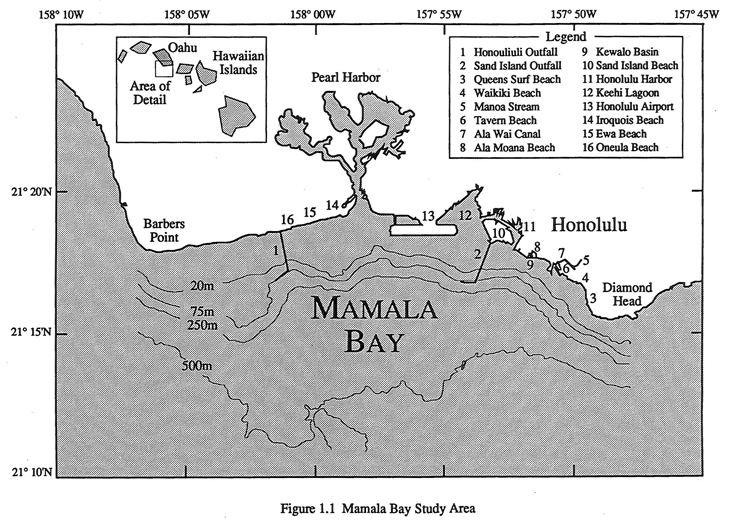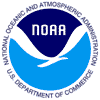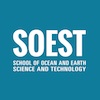Projects : Māmala Bay Water Quality Study
Overview

Study Goal and Objectives
The overall goal of the Māmala Bay Study (1993-1996) was to develop a water quality management plan for Māmala Bay off the South Shore of Oʻahu in Hawaiʻi. To achieve this goal, the study had to provide a sound scientific basis for selecting appropriate actions to protect and enhance the environmental quality of Māmala Bay. This required meeting at least the following specific objectives:
- To collect, collate, and organize all relevant basic data and scientific information on factors affecting the environmental quality of Māmala Bay;
- To identify locations and characterize quantities and qualities of all important point and non-point sources of pollution to Māmala Bay and to determine their relative contributions as functions of seasonal changes in surface runoff and wastewater discharges through outfalls;
- To obtain a quantitative description of hydrodynamics of the interaction between wastewater plumes discharged from ocean outfalls and the ambient ocean environment, including a description of density structure in the initial mixing zones at the Sand Island and Honouliuli outfalls;
- To obtain a quantitative description of the three-dimensional ocean current system of Māmala Bay, including seasonal variability of drift and wind-driven currents, tidal effects on currents, and oceanographic mechanisms affecting transport, dilution, and dispersion of polluting substances in Māmala Bay;
- To characterize microbiological components of the polluting wastewaters, using techniques to quantify concentrations of indicator organisms and pathogens, and to assess the viability and persistence of human pathogenic bacteria and viruses in the ocean environment;
- To simulate the transport and fate of polluting substances and microorganisms (bacterial and viral pathogens) of sewage origin in the ocean environment and to estimate the potential for exposure by contact with contaminated water in areas of recreational use;
- To estimate the concentration of disease-producing microbiological organisms in discharges from point and non-point sources, and to assess their persistence in the ocean environment and potential transport to receptors;
- To assess risks to public health by exposure to contaminated ocean waters;
- To determinate impacts of wastewater discharges on indigenous aquatic flora and fauna, including potential changes in the benthic habitat; and
- To develop alternatives for improvement of water quality in Māmala Bay and guidelines for monitoring the efficacy of implemented management strategies.
Study Setting
For the purposes of the Study, Māmala Bay included all ocean areas from Diamond Head to Barbers Point, Oʻahu. The study area extended offshore of the Bay coastline and included all ocean waters and point sources of pollution that could directly impact the quality of the near-shore aquatic environment. In addition, the study area extended a sufficient distance inshore of the coastline to include significant non-point sources that could affect the quality of near-shore waters. These included sources within the Māmala Bay watershed such as the Ala Wai Canal. The limits of the study area and locations of different sampling sites are shown in the map above.
 |
 |
 |
 |
 |
Reports
These Māmala Bay Study reports were prepared in order to document in detail the scientific investigations conducted during the course of the study (1993-1996), and to present the conclusions and recommendations of the Commission, which are documented in a series of technical reports, MB-1 through MB-10. Chapter MB-1, prepared by the Māmala Bay Study Commission, describes the background for the study, the charge to the Commission, the specific objectives of the study and its organization, and brief descriptions of the various projects and responsible contractors. Chapters MB-2 through MB-10, MB-11A, MB-SP2, and MB-SP4 present the results of investigations contracted by the Commission, authored by the responsible principal investigators, each with their independent conclusions and recommendations. Chapter MB-11, Water Quality Management for Māmala Bay, was prepared by the commissioners themselves, drawing on results of contracted studies and the counsel of principal investigators. Conclusions and recommendations are those of the Commission alone.
| Project | Project Title | Investigators (Year) | Related Data (Accession ID) |
|---|---|---|---|
| MB-1 | Study Management | Colwell, Orlob, Schubel (1996) | |
| MB-2 | Māmala Database | Kimmerer, Garcia Associates (1996) | |
| MB-3 | Pollutant Source Identification | Stevenson, O’Connor (1996) | 0001188 |
| MB-4 | Plume Modeling | Roberts (1995) | |
| MB-5 | Modeling Transport and Fate of Pathogenic Organisms in Māmala Bay | Blumberg, Connolly (1996) | |
| MB-6 | Ocean Current Measurements | Hamilton, Singer, Waddell (1995) | 9600024 |
| MB-SP-2 | Plume Dynamics and Dispersion in Māmala Bay, Hawaiʻi | Jones, Dickey (1995) | |
| MB-7.1 | Characterization of the Microbiological Quality of Water in Māmala Bay | Fujioka (1995) | 9800149 |
| MB-7.2 | Overall Impact of Sand Island Outfall on the Incidence of Pathogens in Māmala Bay | Gerba, Pepper (1995) | 9800151 |
| MB-7.3 | Risk of Swimming-Acquired Illnesses in Māmala Bay | Gerba, Haas, Rose (1995) | 9800151 9800152b |
| MB-7.4 | Molecular Investigation of the Effect of Pollution on Pathogenic and Indigenous Bacteria in Māmala Bay | Hill (1995) | 9800147 |
| MB-7.5 | Microbial Aspects of Point and Non-Point Source Pollution in Māmala Bay | Landry, Dobbs (1995) | 9800152 |
| MB-7.6 | Coliphage and Indigenous Phage in Māmala Bay | Paul, Rose (1995) | 9800152b |
| MB-7.7 | Viability of Cryptosporidium parvum in Marine Waters | Rose (1995) | 9800152b |
| MB-SP-3 | Incidence of Staphylococcus aureus in Māmala Bay | Fujioka, Hill (1995) | 9800147 9800149 |
| MB-9.1 | Definition of Indicator Species for Pollution Monitoring in Māmala Bay, Oʻahu, Hawaiʻi | Bailey-Brock (1995) | 9900121 |
| MB-9.2 | Impact of Point and Non-Point Source Pollution on Coral Reef Ecosystems in Māmala Bay | Grigg (1995) | 0001172 |
| MB-9.3 | Shallow Marine Community Response to Point and Non-Point Sources of Pollution in Māmala Bay, Oʻahu Part A: Fish and Coral Communities |
Kay, Bailey-Brock, Brock (1995) | 9800170 9800174 9900121 |
| MB-9.4 | Shallow Marine Community Response to Point and Non-Point Sources of Pollution in Māmala Bay, Oʻahu Part B: Micromolluscan Assemblages and Algal Biomass |
Kay, Brock (1995) | 9800169 9800174 |
| MB-9.5 | Effects of Sewage Discharges and Stream Runoff on Phytoplanton Communities and Water Quality in Māmala Bay | Laws, Ziemann (1995) | 9800170 9900064 |
| MB-9.6 | Temporal Variability in Macrobenthic Community Structure and the Effect of Freshwater Runoff | McCarthy, Kay, Bailey-Brock (1995) | 9900120 9900121 |
| MB-9.7 | Recruitment Patterns of Marine Benthic Invertebrates in Māmala Bay: A Process-Oriented Measure of Ecosystem Response to Pollution | Smith, Parnell (1995) | 9600041 9900151 |
| MB-10.1 | Envrionmental Impacts on Receptors and Resources Part 1: Management Alternatives and Management Measures for Waste Discharges to the Māmala Bay Ecosystem |
O’Connor, Courtney (1995) | |
| MB-10.2 | Environmental Impacts on Receptors and Resources Part 2: Identification of Stressors of Concern in the Māmala Bay Ecosystem |
O’Connor (1995) | |
| MB-10.3 | Environmental Impacts on Receptors and Resources Part 3: Effects of Effluent from the Barbers Point and Sand Island Outfalls on the Māmala Bay Ecosystem |
Kimmerer, O’Connor (1995) | |
| MB-10.4 | Environmental Impacts on Receptors and Resources Part 4: Proposed Monitoring Plan to Assess Environmental Quality in Māmala Bay and the Māmala Bay Watershed |
O’Connor (1995) | |
| MB-10.5 | Infectious Disease Public Health Risk Assessment | Cooper, Olivieri (1995) | |
| MB-11 | Water Quality Management for Māmala Bay | Colwell, Orlob, Schubel (1996) | |
| MB-11A | Wastewater Management Strategies in an Integrated Coastal Management Plan for Māmala Bay | Harleman (1996) |
Data Sets
The purpose of this study is to observe the physical, chemical, biological, and geophysical nature of Māmala Bay, Oʻahu, Hawaiʻi and surrounding areas in an effort to detect influences from point and non-point source pollution. The table below contains multiple interdisciplinary datasets—refer to NOAA National Oceanographic Data Center (NODC) Accession ID numbers under the Data column for further details.
| Investigators (Year) | Title | Variables | Data |
|---|---|---|---|
| Bailey-Brock, Julie (1994) | Sediment Dwelling Benthos as Indicator Species for Pollution Monitoring of Māmala Bay, Oʻahu, Hawaiʻi, 1993-1994 | taxa, nitrogen, sediment grain size | 9900121 |
| Brock, Richard E. (1995) | Algal Species and Other Data from Various Small Vessels from 1994-08-25 to 1995-05-22 | coral species, algae species, invertebrate species, substrate | 9800169 |
| Fujioka, Roger (1995) | Zooplankton Data Collected from Swimmer/Diver in Coastal Waters of Hawaiʻi from 1995-02-07 to 1995-03-15 | water quality, temperature, salinity, nutrients | 9800149 |
| Gerba, Charles (1994) | Zooplankton Data Collected from Swimmer/Diver in Coastal Waters of Hawaiʻi from 1993-10-25 to 1994-11-18 | water quality, pathogens, viruses | 9800151 |
| Grigg, Richard (1994) | Impact of Point and Non-Point Source Pollution on Coral Reef Ecosystems in Māmala Bay, Oʻahu, Hawaiʻi Based on Water Quality Measurements and Benthic Surveys in 1993-1994 | coral coverage, coral diversity, calcification, bioerosion, water qualiy, sedimentation | 0001172 |
| Hamilton, Peter (1995) | Salinity and Sigma-t Data from CTD Casts in the TOGA Area – Pacific Ocean from 1994-01-06 to 1995-08-03 | currents, temperature, salinity, pressure | 9600024 |
| Hill, Russell (1994) | Bacteria and Bacterial Density and Other Data from 1993-10-25 to 1994-06-23 | water quality, total bacterial counts, culturable bacterial counts, DNA concentration | 9800147 |
| Kay, Alison E. (1994) | Physical and Biological Properties at 10-m Depth Offshore of the Ala Wai Canal, Oʻahu, Hawaiʻi from 1993-1994 | temperature, salinity, grain size | 9900120 |
| Kay, Alison E. (1995) | Zooplankton Data Collected from Swimmer/Diver in Coastal Waters of Hawaiʻi from 1994-06-01 to 1995-12-31 | algae species, mollusks | 9800174 |
| Landry, Mike (1994) | Hydrocarbons – Total Resolved, CAS (Chemical Abstracts Service) Parameter Codes, PCB, and Other Data from Swimmer/Diver from 1993-10-01 to 1994-11-01 | water quality, microbiology, water chemistry | 9800152 |
| Laws, Edward (1994) | Temperature, Salinity, and Nutrients from Near Surface Shallow Water Samples of Māmala Bay Project MB-9, Ecosystem Response Study (1993-1994), on Oʻahu, Hawaiʻi | water quality, temperature, salinity, nutrients | 9900064 |
| Parnell, Ed (1995) | Water Pressure and Other Data from Fixed Platform from TOGA Area – Pacific (30°N to 30°S) from 1994-02-10 to 1995-09-15 | temperature, pressure | 9600041 |
| Rose, Joan (1994) | water quality, coliphage | 9800152b | |
| Smith, Craig (1994) | Benthic Species and Other Data from Swimmer/Diver from 1994-02-01 to 1994-08-02 | taxa | 9900151 |
| Stevenson, Marty (1994) | Two 24-Hour Studies of Water Quality in the Ala Wai Canal during March and July, 1994 for the Māmala Bay Study, Pollutant Source Identification Project MB-3 | water quality, temperature, salinity, bacteria | 0001188 |
| Tanimoto, Ross (1995) | Physical and Water Quality Data Collected Near Honolulu, Hawaiʻi, Waste Water Treatment Plants to Assess the Amount of Pollutants in the Adjacent Waters, 1986 – 1995 | water quality, bacteria, CTD, discharge | 0000795 |
| Teruya, Terry (1994) | Phaeopigments, Chemical, and Other Data from Salinometer, Fluorometer, and Other Instruments in the Coastal Waters of Hawaiʻi as part of the Māmala Bay Study Project, 1989-1994 | water quality | 9800089 |
| Wasnich, Ian (1998) | Temperature Measurements from a Moored Thermistor Chain in Māmala Bay, Oʻahu, Hawaiʻi during 1997-1998 | temperature | 0000625 |
| Ziemann, David A. (1994) | Light Transmission and Other Data from 1993-12-01 to 1994-12-31 | temperature, salinity, chlorophyll, NFP, incident and underwater PAR | 9800170 |
Acknowledgments
The Māmala Bay Study Commission is pleased to acknowledge the contributions of the many individuals and agencies that have facilitated this first comprehensive investigation in the concept of Integrated Coastal Management. We especially wish to express our appreciation to our able assistants, Ms. Camilla Saviz, Shino Tanikawa, Jeanne Gulnick, and Dr. William Straube, for their invaluable expeditious and conscientious attention to the many technical and administrative details of the study. It could not have been completed in a timely manner without their dedication.
Our local office in Honolulu functioned throughout the study period due to the prompt and courteous attention of our local assistants in Honolulu, Ms. Julie Cone, Andrea Ferst, Veronica Carreira, and Dawn Burton who responded to the many public inquiries and requests for information about the study. We wish to express our most sincere appreciation to the Hawaiʻi Community Foundation, especially to Ms. Janet Oshiro and Ms. Janis Reischmann, for the efficient management of the fiscal and administrative activities of the study.
During the course of the study the Commission received the expert advice and counsel of specialists in various relevant fields. Drs. William Eichbaum and Robert Knecht contributed from their experience with Integrated Coastal Management; Drs. Ian Kind, Donald Pritchard, Donald Harleman, Frederick Pfaender, Anne Summers, Gordon McFeters, and John Largier provided guidance on different expert review panels for oceanography, modeling, and microbiological techniques.
Various agencies provided valuable information and assistance to the Commission during the course of the study. The Commission wishes to acknowledge in particular the cooperation and assistance of the Department of Oceanography of the University of Hawaiʻi at Mānoa (UH), Dr. Roger Fujioka, Ms. Kimberly Roll, and the Water Resources Research Center at UH for hosting and coordinating MB-7 project teams, the Sea Grant College Program at UH, the United States Navy and Coast Guard for their cooperation in field programs, the National Oceanographic and Atmospheric Agency (NOAA), and the State of Hawaiʻi Department of Health for making available useful data and information on Māmala Bay. The Commission gratefully acknowledges assistance provided to field programs conducted during the course of the study by persons and groups, including Edward K. Noda and Associates, the staff at American Workboats, and the captains and crews of M/V Holokai, the M/V American Contender, and the R/V Kila. The cooperation of the City and County of Honolulu, in particular Mr. Ross Tanimoto, in providing access to records of wastewater treatment plant performance and field survey information is also much appreciated. The enthusiastic assistance and support provided by many individuals and organizations was instrumental in successful completion of the Māmala Bay Study.







